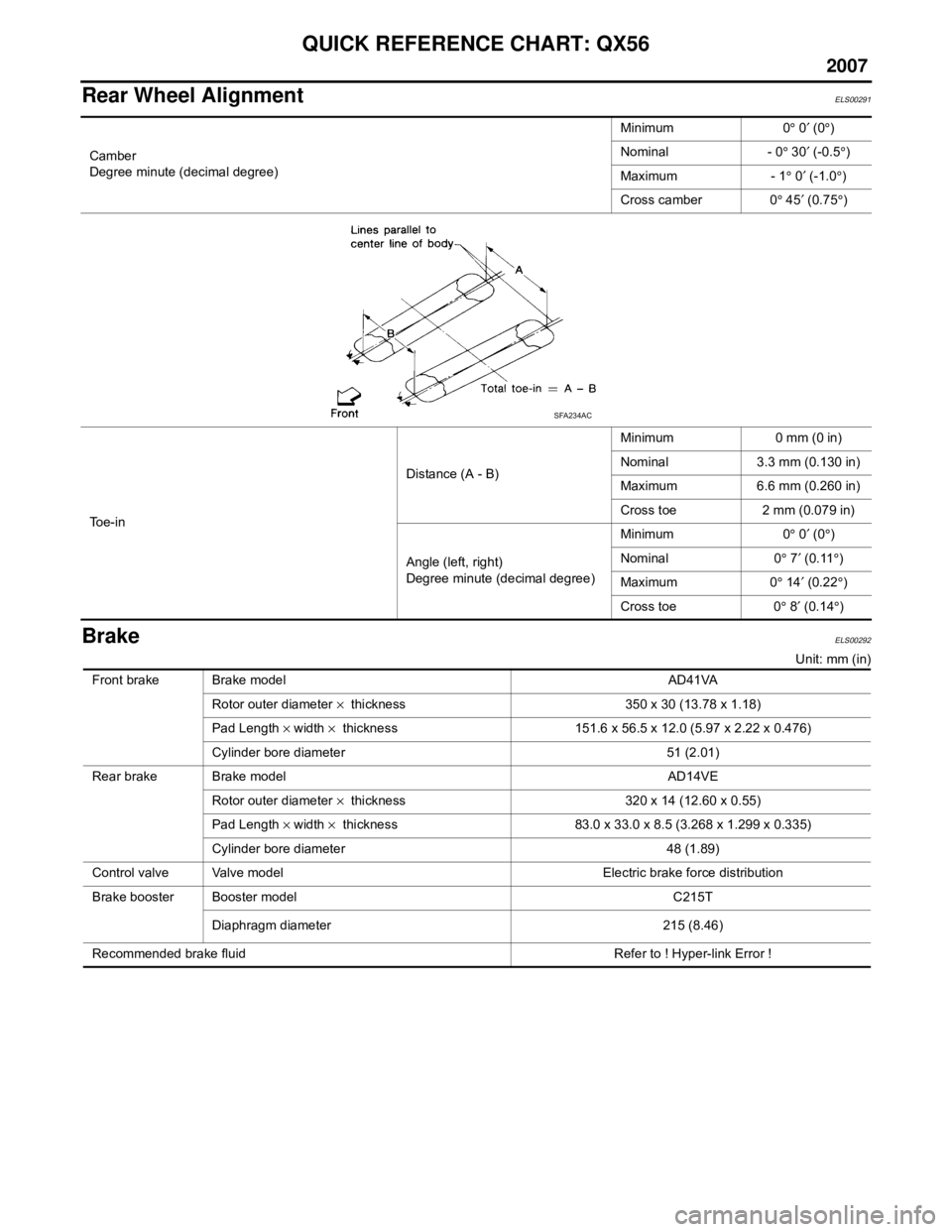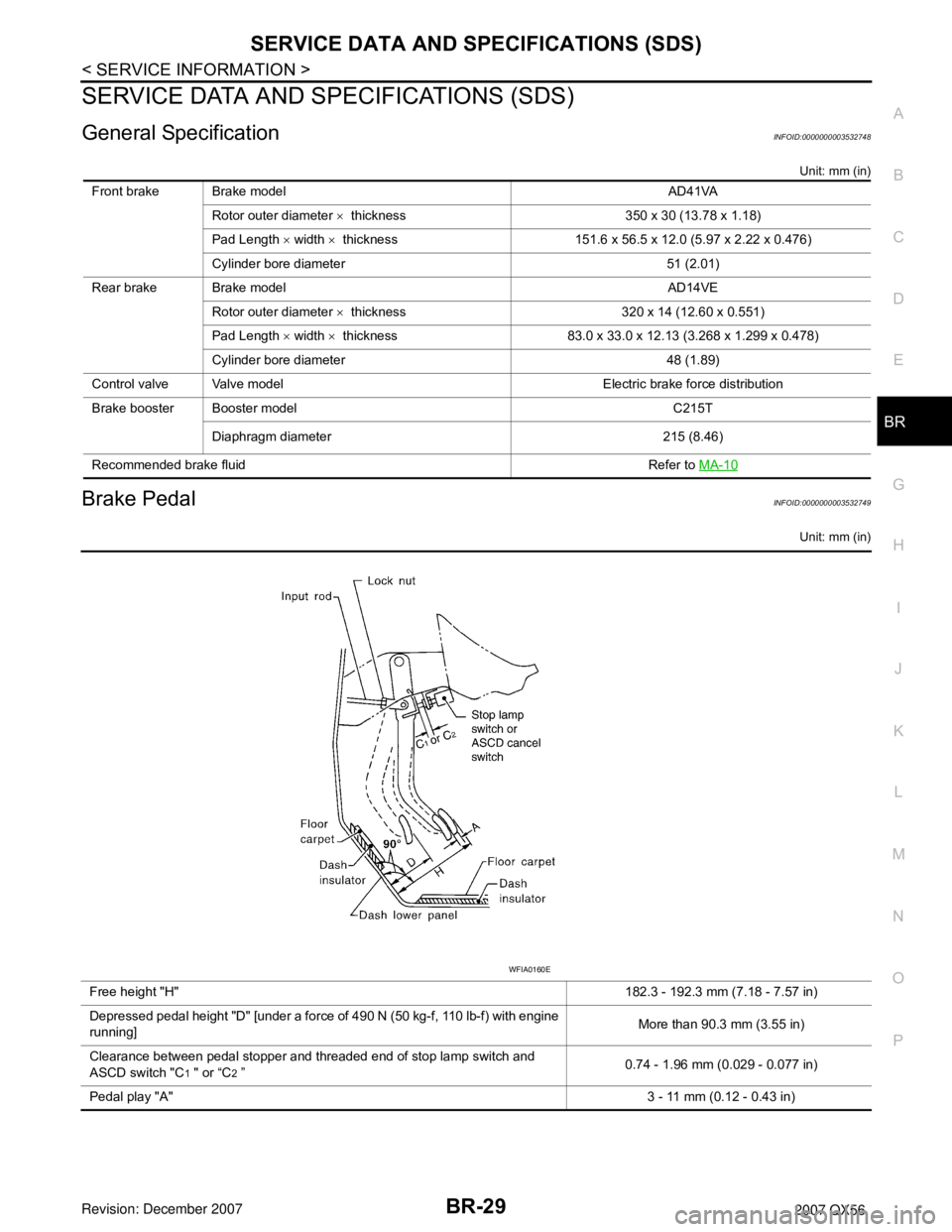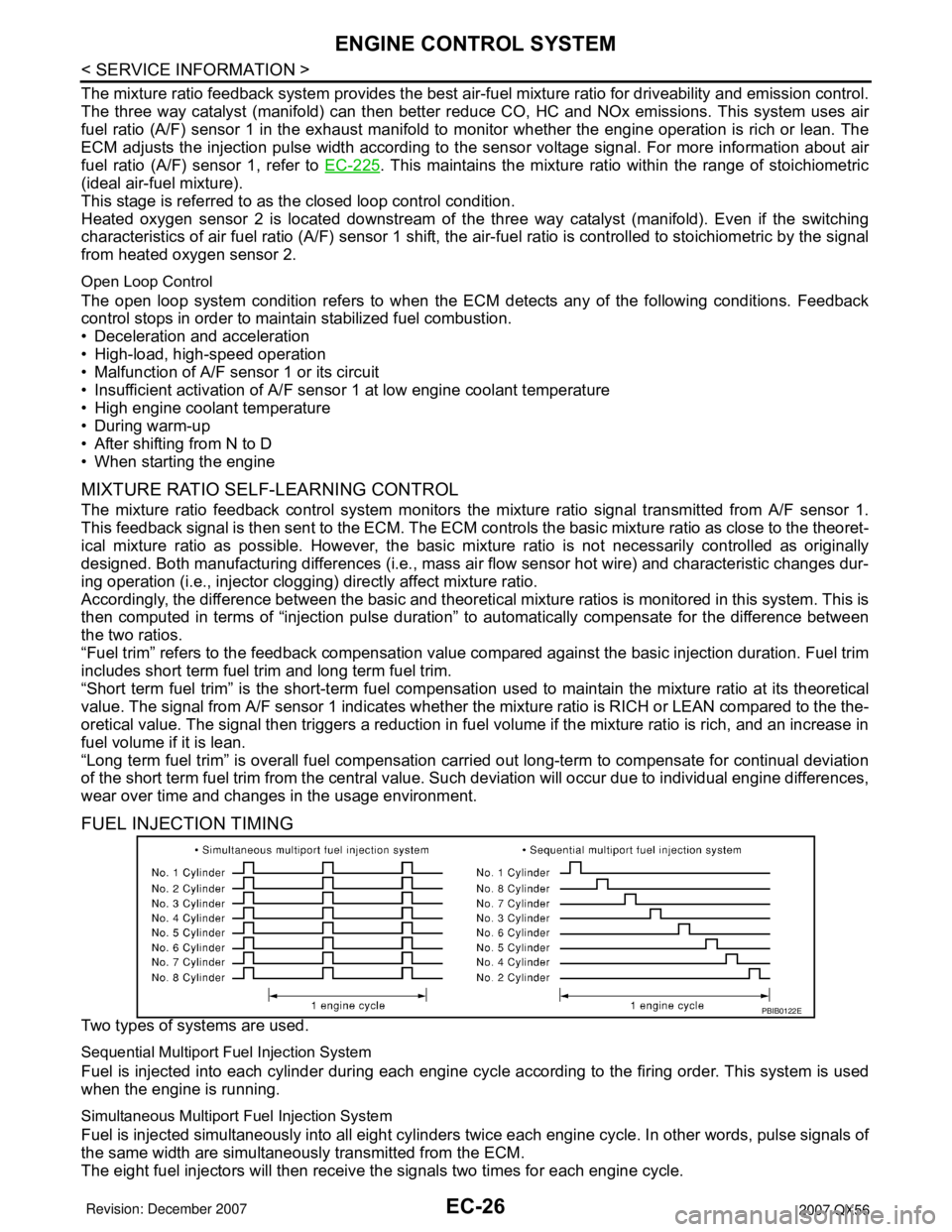2007 INFINITI QX56 width
[x] Cancel search: widthPage 6 of 3061

QUICK REFERENCE CHART: QX56
2007
Rear Wheel AlignmentELS00291
BrakeELS00292
Unit: mm (in)
Camber
Degree minute (decimal degree)
Minimum 0
° 0 ′ (0 °)
Nominal - 0 ° 30 ′ (-0.5 °)
Maximum - 1 ° 0 ′ (-1.0 °)
Cross camber 0 ° 45 ′ (0.75 °)
To e - i n Distance (A - B)
Minimum 0 mm (0 in)
Nominal 3.3 mm (0.130 in)
Maximum 6.6 mm (0.260 in)
Cross toe 2 mm (0.079 in)
Angle (left, right)
Degree minute (decimal degree) Minimum 0
° 0 ′ (0 °)
Nominal 0 ° 7 ′ (0.11 °)
Maximum 0 ° 14 ′ (0.22 °)
Cross toe 0 ° 8 ′ (0.14 °)
SFA234AC
Front brake Brake model AD41VA
Rotor outer diameter × thickness 350 x 30 (13.78 x 1.18)
Pad Length × width × thickness 151.6 x 56.5 x 12.0 (5.97 x 2.22 x 0.476)
Cylinder bore diameter 51 (2.01)
Rear brake Brake model AD14VE Rotor outer diameter × thickness 320 x 14 (12.60 x 0.55)
Pad Length × width × thickness 83.0 x 33.0 x 8.5 (3.268 x 1.299 x 0.335)
Cylinder bore diameter 48 (1.89)
Control valve Valve model Electric brake force distribution
Brake booster Booster model C215T
Diaphragm diameter 215 (8.46)
Recommended brake fluid Refer to ! Hyper-link Error !
Page 159 of 3061

TROUBLE DIAGNOSIS
AT-89
< SERVICE INFORMATION >
D
E
F
G
H
I
J
K
L
MA
B
AT
N
O
P
DTC WORK SUPPORT MODE
Display Items List
ATF WARN LAMP (ON-OFF display) — — X
BACK-UP LAMP (ON-OFF display) — — X
STARTER RELAY (ON-OFF display) — — X
PNP SW3 MON (ON-OFF display) — — X
C/V CLB ID1 — — X
C/V CLB ID2 — — X
C/V CLB ID3 — — X
UNIT CLB ID1 — — X
UNIT CLB ID2 — — X
UNIT CLB ID3 — — X
TRGT GR RATIO — — X
TRGT PRES TCC (kPa) — — X
TRGT PRES L/P (kPa) — — X
TRGT PRES I/C (kPa) — — X
TRGT PRE FR/B (kPa) — — X
TRGT PRES D/C (kPa) — — X
TRG PRE HLR/C (kPa) — — X
SHIFT PATTERN — — X
DRV CST JUDGE — — X
START RLY MON — — X
NEXT GR POSI — — X
SHIFT MODE — — X
MANU GR POSI — — X
VEHICLE SPEED (km/h) — XX Vehicle speed recognized by the TCM.
Voltage (V) — — XDisplays the value measured by the voltage
probe.
Frequency (Hz) — — X
The value measured by the pulse probe is dis-
played. DUTY-HI (high) (%) — — X
DUTY-LOW (low) (%) — — X
PLS WIDTH-HI (ms) — — X
PLS WIDTH-LOW (ms) — — XMonitored item (Unit)Monitor Item Selection
Remarks ECU IN-
PUT SIG-
NALSMAIN SIG-
NALSSELEC-
TION
FROM
MENU
DTC work support itemDescription Check item
I/C SOL FUNCTN CHECK* — —
FR/B SOL FUNCTN CHECK* — —
D/C SOL FUNCTN CHECK* — —
HLR/C SOL FUNCTN CHECK* — —
Page 927 of 3061

SERVICE DATA AND SPECIFICATIONS (SDS)
BR-29
< SERVICE INFORMATION >
C
D
E
G
H
I
J
K
L
MA
B
BR
N
O
P
SERVICE DATA AND SPECIFICATIONS (SDS)
General SpecificationINFOID:0000000003532748
Unit: mm (in)
Brake PedalINFOID:0000000003532749
Unit: mm (in)
Front brake Brake model AD41VA
Rotor outer diameter × thickness 350 x 30 (13.78 x 1.18)
Pad Length × width × thickness 151.6 x 56.5 x 12.0 (5.97 x 2.22 x 0.476)
Cylinder bore diameter 51 (2.01)
Rear brake Brake model AD14VE
Rotor outer diameter × thickness 320 x 14 (12.60 x 0.551)
Pad Length × width × thickness 83.0 x 33.0 x 12.13 (3.268 x 1.299 x 0.478)
Cylinder bore diameter 48 (1.89)
Control valve Valve model Electric brake force distribution
Brake booster Booster model C215T
Diaphragm diameter 215 (8.46)
Recommended brake fluid Refer to MA-10
Free height "H"182.3 - 192.3 mm (7.18 - 7.57 in)
Depressed pedal height "D" [under a force of 490 N (50 kg-f, 110 lb-f) with engine
running]More than 90.3 mm (3.55 in)
Clearance between pedal stopper and threaded end of stop lamp switch and
ASCD switch "C
1 " or “C2 ”0.74 - 1.96 mm (0.029 - 0.077 in)
Pedal play "A"3 - 11 mm (0.12 - 0.43 in)
WFIA0160E
Page 1109 of 3061

EC-26
< SERVICE INFORMATION >
ENGINE CONTROL SYSTEM
The mixture ratio feedback system provides the best air-fuel mixture ratio for driveability and emission control.
The three way catalyst (manifold) can then better reduce CO, HC and NOx emissions. This system uses air
fuel ratio (A/F) sensor 1 in the exhaust manifold to monitor whether the engine operation is rich or lean. The
ECM adjusts the injection pulse width according to the sensor voltage signal. For more information about air
fuel ratio (A/F) sensor 1, refer to EC-225
. This maintains the mixture ratio within the range of stoichiometric
(ideal air-fuel mixture).
This stage is referred to as the closed loop control condition.
Heated oxygen sensor 2 is located downstream of the three way catalyst (manifold). Even if the switching
characteristics of air fuel ratio (A/F) sensor 1 shift, the air-fuel ratio is controlled to stoichiometric by the signal
from heated oxygen sensor 2.
Open Loop Control
The open loop system condition refers to when the ECM detects any of the following conditions. Feedback
control stops in order to maintain stabilized fuel combustion.
• Deceleration and acceleration
• High-load, high-speed operation
• Malfunction of A/F sensor 1 or its circuit
• Insufficient activation of A/F sensor 1 at low engine coolant temperature
• High engine coolant temperature
• During warm-up
• After shifting from N to D
• When starting the engine
MIXTURE RATIO SELF-LEARNING CONTROL
The mixture ratio feedback control system monitors the mixture ratio signal transmitted from A/F sensor 1.
This feedback signal is then sent to the ECM. The ECM controls the basic mixture ratio as close to the theoret-
ical mixture ratio as possible. However, the basic mixture ratio is not necessarily controlled as originally
designed. Both manufacturing differences (i.e., mass air flow sensor hot wire) and characteristic changes dur-
ing operation (i.e., injector clogging) directly affect mixture ratio.
Accordingly, the difference between the basic and theoretical mixture ratios is monitored in this system. This is
then computed in terms of “injection pulse duration” to automatically compensate for the difference between
the two ratios.
“Fuel trim” refers to the feedback compensation value compared against the basic injection duration. Fuel trim
includes short term fuel trim and long term fuel trim.
“Short term fuel trim” is the short-term fuel compensation used to maintain the mixture ratio at its theoretical
value. The signal from A/F sensor 1 indicates whether the mixture ratio is RICH or LEAN compared to the the-
oretical value. The signal then triggers a reduction in fuel volume if the mixture ratio is rich, and an increase in
fuel volume if it is lean.
“Long term fuel trim” is overall fuel compensation carried out long-term to compensate for continual deviation
of the short term fuel trim from the central value. Such deviation will occur due to individual engine differences,
wear over time and changes in the usage environment.
FUEL INJECTION TIMING
Two types of systems are used.
Sequential Multiport Fuel Injection System
Fuel is injected into each cylinder during each engine cycle according to the firing order. This system is used
when the engine is running.
Simultaneous Multiport Fuel Injection System
Fuel is injected simultaneously into all eight cylinders twice each engine cycle. In other words, pulse signals of
the same width are simultaneously transmitted from the ECM.
The eight fuel injectors will then receive the signals two times for each engine cycle.
PBIB0122E
Page 1110 of 3061

ENGINE CONTROL SYSTEM
EC-27
< SERVICE INFORMATION >
C
D
E
F
G
H
I
J
K
L
MA
EC
N
P O
This system is used when the engine is being started and/or if the fail-safe system (CPU) is operating.
FUEL SHUT-OFF
Fuel to each cylinder is cut off during deceleration, operation of the engine at excessively high speeds or oper-
ation of the vehicle at excessively high speed.
Electronic Ignition (EI) SystemINFOID:0000000003531587
INPUT/OUTPUT SIGNAL CHART
*1: This signal is sent to the ECM through CAN communication line.
*2: ECM determines the start signal status by the signals of engine speed and battery voltage.
SYSTEM DESCRIPTION
Firing order: 1 - 8 - 7 - 3 - 6 - 5 - 4 -2
The ignition timing is controlled by the ECM to maintain the best air-fuel ratio for every running condition of the
engine. The ignition timing data is stored in the ECM.
The ECM receives information such as the injection pulse width and camshaft position sensor signal. Comput-
ing this information, ignition signals are transmitted to the power transistor.
During the following conditions, the ignition timing is revised by the ECM according to the other data stored in
the ECM.
• At starting
• During warm-up
•At idle
• At low battery voltage
• During acceleration
The knock sensor retard system is designed only for emergencies. The basic ignition timing is programmed
within the anti-knocking zone, if recommended fuel is used under dry conditions. The retard system does not
operate under normal driving conditions. If engine knocking occurs, the knock sensor monitors the condition.
The signal is transmitted to the ECM. The ECM retards the ignition timing to eliminate the knocking condition.
Fuel Cut Control (at No Load and High Engine Speed)INFOID:0000000003531588
INPUT/OUTPUT SIGNAL CHART
*: This signal is sent to the ECM through CAN communication line.Sensor Input signal to ECM ECM function Actuator
Crankshaft position sensor (POS)
Engine speed*
2
Piston position
Ignition timing
controlPower transistor Camshaft position sensor (PHASE)
Mass air flow sensor Amount of intake air
Engine coolant temperature sensor Engine coolant temperature
Throttle position sensor Throttle position
Accelerator pedal position sensor Accelerator pedal position
Knock sensor Engine knocking
Park/neutral position (PNP) switch Gear position
Battery
Battery voltage*
2
Wheel sensor
Vehicle speed*1
Sensor Input signal to ECM ECM function Actuator
Park/neutral position (PNP) switch Neutral position
Fuel cut control Fuel injector Accelerator pedal position sensor Accelerator pedal position
Engine coolant temperature sensor Engine coolant temperature
Crankshaft position sensor (POS)
Camshaft position sensor (PHASE)Engine speed
Wheel sensor Vehicle speed*
Page 1198 of 3061

TROUBLE DIAGNOSIS
EC-115
< SERVICE INFORMATION >
C
D
E
F
G
H
I
J
K
L
MA
EC
N
P O
*: The item is the same as that of 1st trip freeze frame data.
DATA MONITOR MODE
Monitored Item
×: Applicable
B/FUEL SCHDL
[msec]• The base fuel schedule at the moment a malfunction is detected is displayed.
INT/A TEMP SE
[°C] or [°F]• The intake air temperature at the moment a malfunction is detected is displayed. Freeze frame data
item*Description
Monitored item
[Unit]ECM IN-
PUT SIG-
NALSMAIN
SIGNALSDescription Remarks
ENG SPEED [rpm]×ו Indicates the engine speed computed
from the signal of the crankshaft position
sensor (POS) and camshaft position
sensor (PHASE).• Accuracy becomes poor if engine
speed drops below the idle rpm.
• If the signal is interrupted while the en-
gine is running, an abnormal value may
be indicated.
MAS A/F SE-B1 [V]×ו The signal voltage of the mass air flow
sensor is displayed.• When the engine is stopped, a certain
value is indicated.
B/FUEL SCHDL
[msec]ו Base fuel schedule indicates the fuel in-
jection pulse width programmed into
ECM, prior to any learned on board cor-
rection.
A/F ALPHA-B1 [%]×
• The mean value of the air-fuel ratio feed-
back correction factor per cycle is indi-
cated.• When the engine is stopped, a certain
value is indicated.
• This data also includes the data for the
air-fuel ratio learning control. A/F ALPHA-B2 [%]×
COOLAN TEMP/S
[°C] or [°F]×ו The engine coolant temperature (deter-
mined by the signal voltage of the engine
coolant temperature sensor) is dis-
played.• When the engine coolant temperature
sensor is open or short-circuited, ECM
enters fail-safe mode. The engine cool-
ant temperature determined by the
ECM is displayed.
A/F SEN1 (B1) [V]××
• The A/F signal computed from the input
signal of the A/F sensor 1 is displayed.
A/F SEN1 (B2) [V]×
HO2S2 (B1) [V]×
• The signal voltage of the heated oxygen
sensor 2 is displayed.
HO2S2 (B2) [V]×
HO2S2 MNTR (B1)
[RICH/LEAN]ו Display of heated oxygen sensor 2 sig-
nal:
RICH: means the amount of oxygen after
three way catalyst is relatively small.
LEAN: means the amount of oxygen af-
ter three way catalyst is relatively large.• When the engine is stopped, a certain
value is indicated.
HO2S2 MNTR (B2)
[RICH/LEAN]×
VHCL SPEED SE
[km/h] or [mph]×ו The vehicle speed computed from the
vehicle speed signal sent from combina-
tion meter is displayed.
BATTERY VOLT [V]×ו The power supply voltage of ECM is dis-
played.
ACCEL SEN 1 [V]××
• The accelerator pedal position sensor
signal voltage is displayed.• ACCEL SEN 2 signal is converted by
ECM internally. Thus, it differs from
ECM terminal voltage signal. ACCEL SEN 2 [V]×
THRTL SEN 1 [V]××
• The throttle position sensor signal volt-
age is displayed.• THRTL SEN 2 signal is converted by
ECM internally. Thus, it differs from
ECM terminal voltage signal. THRTL SEN 2 [V]×
Page 1199 of 3061
![INFINITI QX56 2007 Factory Service Manual EC-116
< SERVICE INFORMATION >
TROUBLE DIAGNOSIS
FUEL T/TMP SE
[°C] or [°F]ו The fuel temperature (determined by the
signal voltage of the fuel tank tempera-
ture sensor) is displayed.
INT/A T INFINITI QX56 2007 Factory Service Manual EC-116
< SERVICE INFORMATION >
TROUBLE DIAGNOSIS
FUEL T/TMP SE
[°C] or [°F]ו The fuel temperature (determined by the
signal voltage of the fuel tank tempera-
ture sensor) is displayed.
INT/A T](/manual-img/42/57029/w960_57029-1198.png)
EC-116
< SERVICE INFORMATION >
TROUBLE DIAGNOSIS
FUEL T/TMP SE
[°C] or [°F]ו The fuel temperature (determined by the
signal voltage of the fuel tank tempera-
ture sensor) is displayed.
INT/A TEMP SE
[°C] or [°F]×ו The intake air temperature (determined
by the signal voltage of the intake air
temperature sensor) is indicated.
EVAP SYS PRES
[V]ו The signal voltage of EVAP control sys-
tem pressure sensor is displayed.
FUEL LEVEL SE [V]ו The signal voltage of the fuel level sen-
sor is displayed.
START SIGNAL
[ON/OFF]×ו Indicates start signal status [ON/OFF]
computed by the ECM according to the
signals of engine speed and battery volt-
age.• After starting the engine, [OFF] is dis-
played regardless of the starter signal.
CLSD THL POS
[ON/OFF]×ו Indicates idle position [ON/OFF] comput-
ed by ECM according to the accelerator
pedal position sensor signal.
AIR COND SIG
[ON/OFF]×ו Indicates [ON/OFF] condition of the air
conditioner switch as determined by the
air conditioner signal.
P/N POSI SW
[ON/OFF]×ו Indicates [ON/OFF] condition from the
park/neutral position (PNP) switch sig-
nal.
PW/ST SIGNAL
[ON/OFF]×ו [ON/OFF] condition of the power steering
system (determined by the signal voltage
of the power steering pressure sensor
signal) is indicated.
LOAD SIGNAL [ON/
OFF]×ו Indicates [ON/OFF] condition from the
electrical load signal.
ON: Rear window defogger switch is ON
and/or lighting switch is in 2nd position.
OFF: Both rear window defogger switch
and lighting switch are OFF.
IGNITION SW
[ON/OFF]ו Indicates [ON/OFF] condition from igni-
tion switch signal.
HEATER FAN SW
[ON/OFF]ו Indicates [ON/OFF] condition from heat-
er fan switch signal.
BRAKE SW
[ON/OFF]ו Indicates [ON/OFF] condition from the
stop lamp switch signal.
INJ PULSE-B1
[msec]×
• Indicates the actual fuel injection pulse
width compensated by ECM according to
the input signals.• When the engine is stopped, a certain
computed value is indicated.
INJ PULSE-B2
[msec]
IGN TIMING [BT-
DC]ו Indicates the ignition timing computed by
ECM according to the input signals.• When the engine is stopped, a certain
value is indicated.
CAL/LD VALUE [%]• “Calculated load value” indicates the val-
ue of the current air flow divided by peak
air flow.
MASS AIRFLOW
[g·m/s]• Indicates the mass air flow computed by
ECM according to the signal voltage of
the mass air flow sensor. Monitored item
[Unit]ECM IN-
PUT SIG-
NALSMAIN
SIGNALSDescription Remarks
Page 1202 of 3061

TROUBLE DIAGNOSIS
EC-119
< SERVICE INFORMATION >
C
D
E
F
G
H
I
J
K
L
MA
EC
N
P O
NOTE:
Any monitored item that does not match the vehicle being diagnosed is deleted from the display automatically.
DATA MONITOR (SPEC) MODE
Monitored Item
NOTE:
Any monitored item that does not match the vehicle being diagnosed is deleted from the display automatically.
ACTIVE TEST MODE
Test Item
ALT DUTY SIG
[ON/OFF]• The control condition of the power gener-
ation voltage variable control (deter-
mined by ECM according to the input
signals) is indicated.
ON: Power generation voltage variable
control is active.
OFF: Power generation voltage variable
control is inactive.
A/F ADJ-B1 • Indicates the correction factor stored in
ECM. The factor is calculated from the
difference between the target air/fuel ra-
tio stored in ECM and the air-fuel ratio
calculated from air fuel ratio (A/F) sensor
1 signal. A/F ADJ-B2
Voltage [V]
• Voltage, frequency, duty cycle or pulse
width measured by the probe.• Only # is displayed if item is unable to
be measured.
• Figures with #s are temporary ones.
They are the same figures as an actual
piece of data which was just previously
measured. Frequency [msec],
[Hz] or [%]
DUTY-HI
DUTY-LOW
PLS WIDTH-HI
PLS WIDTH-LOWMonitored item
[Unit]ECM IN-
PUT SIG-
NALSMAIN
SIGNALSDescription Remarks
Monitored item
[Unit]ECM IN-
PUT SIG-
NALSMAIN SIG-
NALSDescription Remarks
ENG SPEED [rpm]×ו Indicates the engine speed computed
from the signal of the crankshaft position
sensor (POS) and camshaft position
sensor (PHASE).
MAS A/F SE-B1 [V]×ו The signal voltage of the mass air flow
sensor specification is displayed.• When engine is running specification
range is indicated.
B/FUEL SCHDL
[msec]ו Base fuel schedule indicates the fuel in-
jection pulse width programmed into
ECM, prior to any learned on board cor-
rection.• When engine is running specification
range is indicated.
A/F ALPHA-B1 [%]
A/F ALPHA-B2 [%]ו The mean value of the air-fuel ratio feed-
back correction factor per cycle is indi-
cated.• When engine is running specification
range is indicated.
• This data also includes the data for
the air-fuel ratio learning control.